Deep Learning
Ian Goodfellow
Yoshua Bengio
Aaron Courville
�
Contents
Website
Acknowledgments
Notation
1 Introduction
1.1 Who Should Read This Book? . . . . . . . . . . . . . . . . . . . .
1.2
Historical Trends in Deep Learning . . . . . . . . . . . . . . . . .
I Applied Math and Machine Learning Basics
2 Linear Algebra
2.1
Scalars, Vectors, Matrices and Tensors . . . . . . . . . . . . . . .
2.2 Multiplying Matrices and Vectors . . . . . . . . . . . . . . . . . .
Identity and Inverse Matrices
2.3
. . . . . . . . . . . . . . . . . . . .
Linear Dependence and Span . . . . . . . . . . . . . . . . . . . .
2.4
2.5
Norms . . . . . . . . . . . . . . . . . . . . . . . . . . . . . . . . .
Special Kinds of Matrices and Vectors
2.6
. . . . . . . . . . . . . . .
Eigendecomposition . . . . . . . . . . . . . . . . . . . . . . . . . .
2.7
Singular Value Decomposition . . . . . . . . . . . . . . . . . . . .
2.8
2.9
The Moore-Penrose Pseudoinverse . . . . . . . . . . . . . . . . . .
2.10 The Trace Operator
. . . . . . . . . . . . . . . . . . . . . . . . .
2.11 The Determinant . . . . . . . . . . . . . . . . . . . . . . . . . . .
2.12 Example: Principal Components Analysis
. . . . . . . . . . . . .
3 Probability and Information Theory
3.1 Why Probability? . . . . . . . . . . . . . . . . . . . . . . . . . . .
i
vii
viii
xi
1
8
11
29
31
31
34
36
37
39
40
42
44
45
46
47
48
53
54
�
CONTENTS
. . . . . . . . . . . . . . . . . . . . . . . . . .
Random Variables
3.2
3.3
Probability Distributions . . . . . . . . . . . . . . . . . . . . . . .
3.4 Marginal Probability . . . . . . . . . . . . . . . . . . . . . . . . .
3.5
Conditional Probability . . . . . . . . . . . . . . . . . . . . . . .
The Chain Rule of Conditional Probabilities . . . . . . . . . . . .
3.6
Independence and Conditional Independence . . . . . . . . . . . .
3.7
3.8
Expectation, Variance and Covariance
. . . . . . . . . . . . . . .
. . . . . . . . . . . . . . . . .
3.9
Common Probability Distributions
3.10 Useful Properties of Common Functions
. . . . . . . . . . . . . .
3.11 Bayes’ Rule . . . . . . . . . . . . . . . . . . . . . . . . . . . . . .
3.12 Technical Details of Continuous Variables
. . . . . . . . . . . . .
3.13 Information Theory . . . . . . . . . . . . . . . . . . . . . . . . . .
3.14 Structured Probabilistic Models . . . . . . . . . . . . . . . . . . .
4 Numerical Computation
4.1 Overflow and Underflow . . . . . . . . . . . . . . . . . . . . . . .
4.2
Poor Conditioning . . . . . . . . . . . . . . . . . . . . . . . . . .
4.3 Gradient-Based Optimization . . . . . . . . . . . . . . . . . . . .
Constrained Optimization . . . . . . . . . . . . . . . . . . . . . .
4.4
4.5
Example: Linear Least Squares . . . . . . . . . . . . . . . . . . .
56
56
58
59
59
60
60
62
67
70
71
72
75
80
80
82
82
93
96
5 Machine Learning Basics
98
99
Learning Algorithms . . . . . . . . . . . . . . . . . . . . . . . . .
5.1
Capacity, Overfitting and Underfitting . . . . . . . . . . . . . . . 110
5.2
Hyperparameters and Validation Sets . . . . . . . . . . . . . . . . 120
5.3
5.4
Estimators, Bias and Variance . . . . . . . . . . . . . . . . . . . . 122
5.5 Maximum Likelihood Estimation . . . . . . . . . . . . . . . . . . 131
Bayesian Statistics
5.6
. . . . . . . . . . . . . . . . . . . . . . . . . . 135
Supervised Learning Algorithms . . . . . . . . . . . . . . . . . . . 139
5.7
5.8
Unsupervised Learning Algorithms
. . . . . . . . . . . . . . . . . 145
5.9
Stochastic Gradient Descent . . . . . . . . . . . . . . . . . . . . . 150
5.10 Building a Machine Learning Algorithm . . . . . . . . . . . . . . 152
5.11 Challenges Motivating Deep Learning . . . . . . . . . . . . . . . . 154
II Deep Networks: Modern Practices
165
6 Deep Feedforward Networks
167
Example: Learning XOR . . . . . . . . . . . . . . . . . . . . . . . 170
6.1
6.2 Gradient-Based Learning . . . . . . . . . . . . . . . . . . . . . . . 176
ii
�
CONTENTS
6.3
6.4
6.5
6.6
. . . . . . . . . . . . . . . . . . . . . . . . . . . . . 190
Hidden Units
Architecture Design . . . . . . . . . . . . . . . . . . . . . . . . . . 196
Back-Propagation and Other Differentiation Algorithms
. . . . . 203
Historical Notes . . . . . . . . . . . . . . . . . . . . . . . . . . . . 224
7 Regularization for Deep Learning
228
Parameter Norm Penalties . . . . . . . . . . . . . . . . . . . . . . 230
7.1
Norm Penalties as Constrained Optimization . . . . . . . . . . . . 237
7.2
7.3
. . . . . . . . . 239
Regularization and Under-Constrained Problems
7.4 Dataset Augmentation . . . . . . . . . . . . . . . . . . . . . . . . 240
7.5
Noise Robustness . . . . . . . . . . . . . . . . . . . . . . . . . . . 242
7.6
Semi-Supervised Learning . . . . . . . . . . . . . . . . . . . . . . 244
7.7 Multi-Task Learning . . . . . . . . . . . . . . . . . . . . . . . . . 245
7.8
Early Stopping . . . . . . . . . . . . . . . . . . . . . . . . . . . . 246
7.9
Parameter Tying and Parameter Sharing . . . . . . . . . . . . . . 251
7.10 Sparse Representations . . . . . . . . . . . . . . . . . . . . . . . . 253
7.11 Bagging and Other Ensemble Methods . . . . . . . . . . . . . . . 255
7.12 Dropout . . . . . . . . . . . . . . . . . . . . . . . . . . . . . . . . 257
7.13 Adversarial Training . . . . . . . . . . . . . . . . . . . . . . . . . 267
7.14 Tangent Distance, Tangent Prop, and Manifold Tangent Classifier 268
8 Optimization for Training Deep Models
274
How Learning Differs from Pure Optimization . . . . . . . . . . . 275
8.1
Challenges in Neural Network Optimization . . . . . . . . . . . . 282
8.2
Basic Algorithms . . . . . . . . . . . . . . . . . . . . . . . . . . . 294
8.3
Parameter Initialization Strategies
. . . . . . . . . . . . . . . . . 301
8.4
Algorithms with Adaptive Learning Rates . . . . . . . . . . . . . 306
8.5
8.6
Approximate Second-Order Methods . . . . . . . . . . . . . . . . 310
8.7 Optimization Strategies and Meta-Algorithms . . . . . . . . . . . 317
9 Convolutional Networks
330
9.1
The Convolution Operation . . . . . . . . . . . . . . . . . . . . . 331
9.2 Motivation . . . . . . . . . . . . . . . . . . . . . . . . . . . . . . . 335
Pooling . . . . . . . . . . . . . . . . . . . . . . . . . . . . . . . . . 339
9.3
Convolution and Pooling as an Infinitely Strong Prior . . . . . . . 345
9.4
9.5
Variants of the Basic Convolution Function . . . . . . . . . . . . 347
9.6
Structured Outputs . . . . . . . . . . . . . . . . . . . . . . . . . . 358
9.7 Data Types . . . . . . . . . . . . . . . . . . . . . . . . . . . . . . 360
9.8
. . . . . . . . . . . . . . . . . . 362
. . . . . . . . . . . . . . . . . 363
9.9
Efficient Convolution Algorithms
Random or Unsupervised Features
iii
�
CONTENTS
9.10 The Neuroscientific Basis for Convolutional Networks . . . . . . . 364
9.11 Convolutional Networks and the History of Deep Learning . . . . 371
10 Sequence Modeling: Recurrent and Recursive Nets
373
10.1 Unfolding Computational Graphs . . . . . . . . . . . . . . . . . . 375
10.2 Recurrent Neural Networks
. . . . . . . . . . . . . . . . . . . . . 378
10.3 Bidirectional RNNs . . . . . . . . . . . . . . . . . . . . . . . . . . 395
10.4 Encoder-Decoder Sequence-to-Sequence Architectures . . . . . . . 396
10.5 Deep Recurrent Networks
. . . . . . . . . . . . . . . . . . . . . . 398
10.6 Recursive Neural Networks . . . . . . . . . . . . . . . . . . . . . . 400
10.7 The Challenge of Long-Term Dependencies . . . . . . . . . . . . . 402
10.8 Echo State Networks . . . . . . . . . . . . . . . . . . . . . . . . . 405
10.9 Leaky Units and Other Strategies for Multiple Time Scales . . . . 408
10.10 The Long Short-Term Memory and Other Gated RNNs . . . . . . 410
10.11 Optimization for Long-Term Dependencies . . . . . . . . . . . . . 414
10.12 Explicit Memory . . . . . . . . . . . . . . . . . . . . . . . . . . . 418
11 Practical methodology
423
11.1 Performance Metrics . . . . . . . . . . . . . . . . . . . . . . . . . 424
11.2 Default Baseline Models . . . . . . . . . . . . . . . . . . . . . . . 427
11.3 Determining Whether to Gather More Data . . . . . . . . . . . . 428
11.4 Selecting Hyperparameters . . . . . . . . . . . . . . . . . . . . . . 429
11.5 Debugging Strategies . . . . . . . . . . . . . . . . . . . . . . . . . 438
11.6 Example: Multi-Digit Number Recognition . . . . . . . . . . . . . 442
12 Applications
445
12.1 Large Scale Deep Learning . . . . . . . . . . . . . . . . . . . . . . 445
12.2 Computer Vision . . . . . . . . . . . . . . . . . . . . . . . . . . . 454
12.3 Speech Recognition . . . . . . . . . . . . . . . . . . . . . . . . . . 460
12.4 Natural Language Processing . . . . . . . . . . . . . . . . . . . . 463
12.5 Other Applications . . . . . . . . . . . . . . . . . . . . . . . . . . 479
III Deep Learning Research
488
13 Linear Factor Models
491
13.1 Probabilistic PCA and Factor Analysis . . . . . . . . . . . . . . . 492
13.2 Independent Component Analysis (ICA) . . . . . . . . . . . . . . 493
13.3 Slow Feature Analysis
. . . . . . . . . . . . . . . . . . . . . . . . 495
13.4 Sparse Coding . . . . . . . . . . . . . . . . . . . . . . . . . . . . . 498
iv
�
CONTENTS
13.5 Manifold Interpretation of PCA . . . . . . . . . . . . . . . . . . . 501
14 Autoencoders
504
14.1 Undercomplete Autoencoders
. . . . . . . . . . . . . . . . . . . . 505
14.2 Regularized Autoencoders . . . . . . . . . . . . . . . . . . . . . . 506
14.3 Representational Power, Layer Size and Depth . . . . . . . . . . . 510
14.4 Stochastic Encoders and Decoders . . . . . . . . . . . . . . . . . . 511
14.5 Denoising Autoencoders . . . . . . . . . . . . . . . . . . . . . . . 512
14.6 Learning Manifolds with Autoencoders . . . . . . . . . . . . . . . 517
14.7 Contractive Autoencoders . . . . . . . . . . . . . . . . . . . . . . 523
14.8 Predictive Sparse Decomposition . . . . . . . . . . . . . . . . . . 525
14.9 Applications of Autoencoders . . . . . . . . . . . . . . . . . . . . 526
15 Representation Learning
528
15.1 Greedy Layer-Wise Unsupervised Pretraining . . . . . . . . . . . 530
15.2 Transfer Learning and Domain Adaptation . . . . . . . . . . . . . 538
15.3 Semi-Supervised Disentangling of Causal Factors
. . . . . . . . . 543
15.4 Distributed Representation . . . . . . . . . . . . . . . . . . . . . . 548
15.5 Exponential Gains from Depth . . . . . . . . . . . . . . . . . . . 555
15.6 Providing Clues to Discover Underlying Causes . . . . . . . . . . 556
16 Structured Probabilistic Models for Deep Learning
560
16.1 The Challenge of Unstructured Modeling . . . . . . . . . . . . . . 561
16.2 Using Graphs to Describe Model Structure . . . . . . . . . . . . . 565
16.3 Sampling from Graphical Models . . . . . . . . . . . . . . . . . . 582
16.4 Advantages of Structured Modeling . . . . . . . . . . . . . . . . . 584
16.5 Learning about Dependencies . . . . . . . . . . . . . . . . . . . . 584
16.6 Inference and Approximate Inference . . . . . . . . . . . . . . . . 585
16.7 The Deep Learning Approach to Structured Probabilistic Models 586
17 Monte Carlo Methods
592
17.1 Sampling and Monte Carlo Methods
. . . . . . . . . . . . . . . . 592
17.2 Importance Sampling . . . . . . . . . . . . . . . . . . . . . . . . . 594
17.3 Markov Chain Monte Carlo Methods . . . . . . . . . . . . . . . . 597
17.4 Gibbs Sampling . . . . . . . . . . . . . . . . . . . . . . . . . . . . 601
17.5 The Challenge of Mixing between Separated Modes . . . . . . . . 601
18 Confronting the Partition Function
607
18.1 The Log-Likelihood Gradient
. . . . . . . . . . . . . . . . . . . . 608
18.2 Stochastic Maximum Likelihood and Contrastive Divergence . . . 609
v
�
CONTENTS
18.3 Pseudolikelihood . . . . . . . . . . . . . . . . . . . . . . . . . . . 617
18.4 Score Matching and Ratio Matching . . . . . . . . . . . . . . . . 619
18.5 Denoising Score Matching . . . . . . . . . . . . . . . . . . . . . . 621
18.6 Noise-Contrastive Estimation . . . . . . . . . . . . . . . . . . . . 622
18.7 Estimating the Partition Function . . . . . . . . . . . . . . . . . . 625
19 Approximate inference
633
19.1 Inference as Optimization . . . . . . . . . . . . . . . . . . . . . . 635
19.2 Expectation Maximization . . . . . . . . . . . . . . . . . . . . . . 636
19.3 MAP Inference and Sparse Coding . . . . . . . . . . . . . . . . . 637
19.4 Variational Inference and Learning . . . . . . . . . . . . . . . . . 640
19.5 Learned Approximate Inference . . . . . . . . . . . . . . . . . . . 653
20 Deep Generative Models
656
20.1 Boltzmann Machines . . . . . . . . . . . . . . . . . . . . . . . . . 656
20.2 Restricted Boltzmann Machines . . . . . . . . . . . . . . . . . . . 658
20.3 Deep Belief Networks . . . . . . . . . . . . . . . . . . . . . . . . . 662
20.4 Deep Boltzmann Machines . . . . . . . . . . . . . . . . . . . . . . 665
20.5 Boltzmann Machines for Real-Valued Data . . . . . . . . . . . . . 678
20.6 Convolutional Boltzmann Machines . . . . . . . . . . . . . . . . . 685
20.7 Boltzmann Machines for Structured or Sequential Outputs . . . . 687
20.8 Other Boltzmann Machines
. . . . . . . . . . . . . . . . . . . . . 688
20.9 Back-Propagation through Random Operations . . . . . . . . . . 689
20.10 Directed Generative Nets . . . . . . . . . . . . . . . . . . . . . . . 694
20.11 Drawing Samples from Autoencoders . . . . . . . . . . . . . . . . 712
20.12 Generative Stochastic Networks . . . . . . . . . . . . . . . . . . . 716
20.13 Other Generation Schemes . . . . . . . . . . . . . . . . . . . . . . 717
20.14 Evaluating Generative Models . . . . . . . . . . . . . . . . . . . . 719
20.15 Conclusion . . . . . . . . . . . . . . . . . . . . . . . . . . . . . . . 721
Bibliography
Index
723
780
vi
�
Website
www.deeplearningbook.org
This book is accompanied by the above website. The website provides a
variety of supplementary material, including exercises, lecture slides, corrections of
mistakes, and other resources that should be useful to both readers and instructors.
vii
�
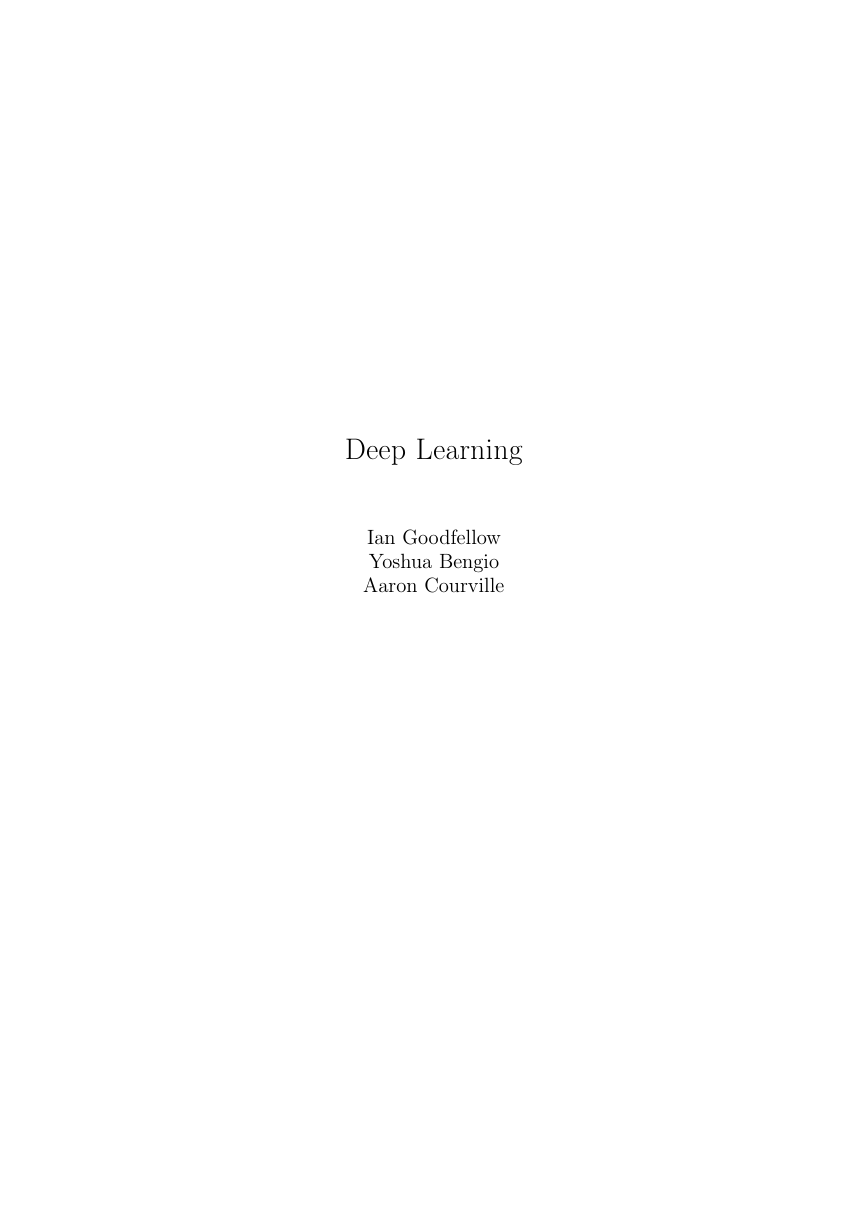
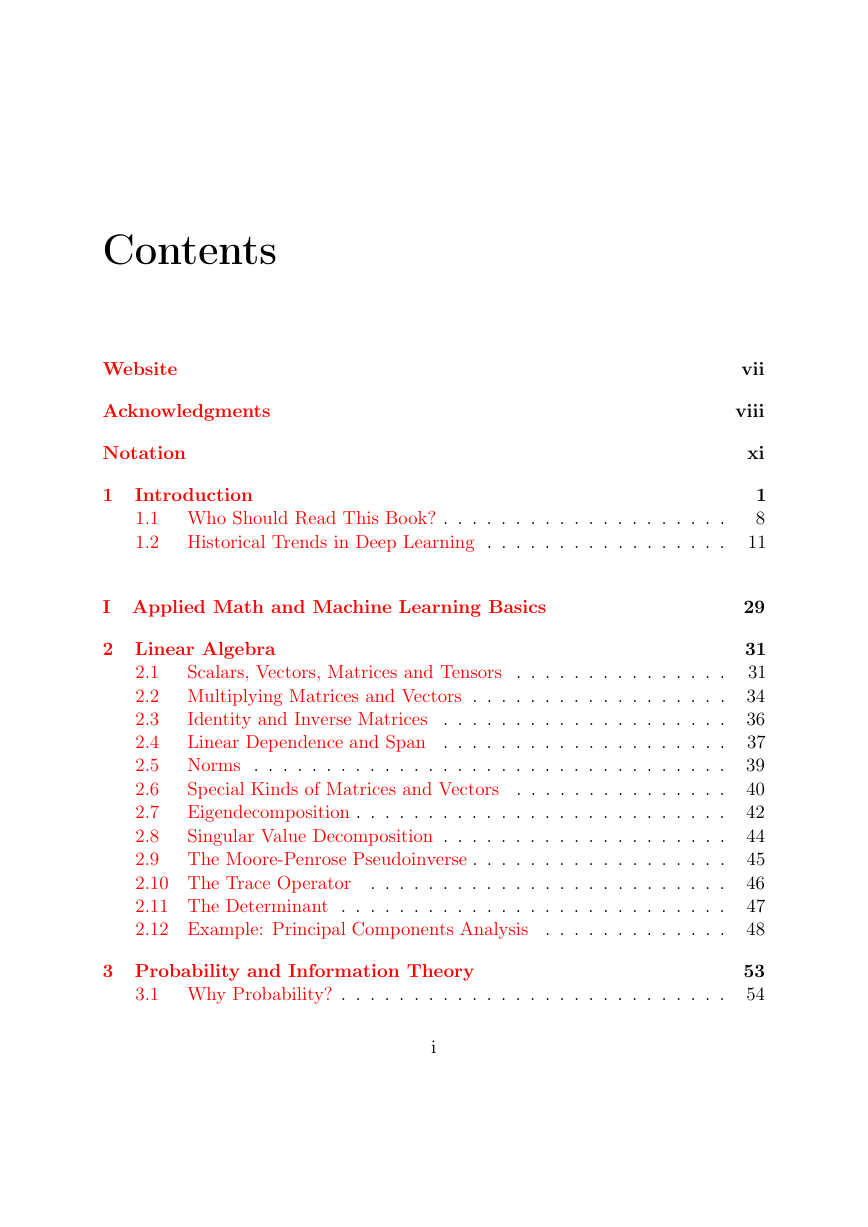
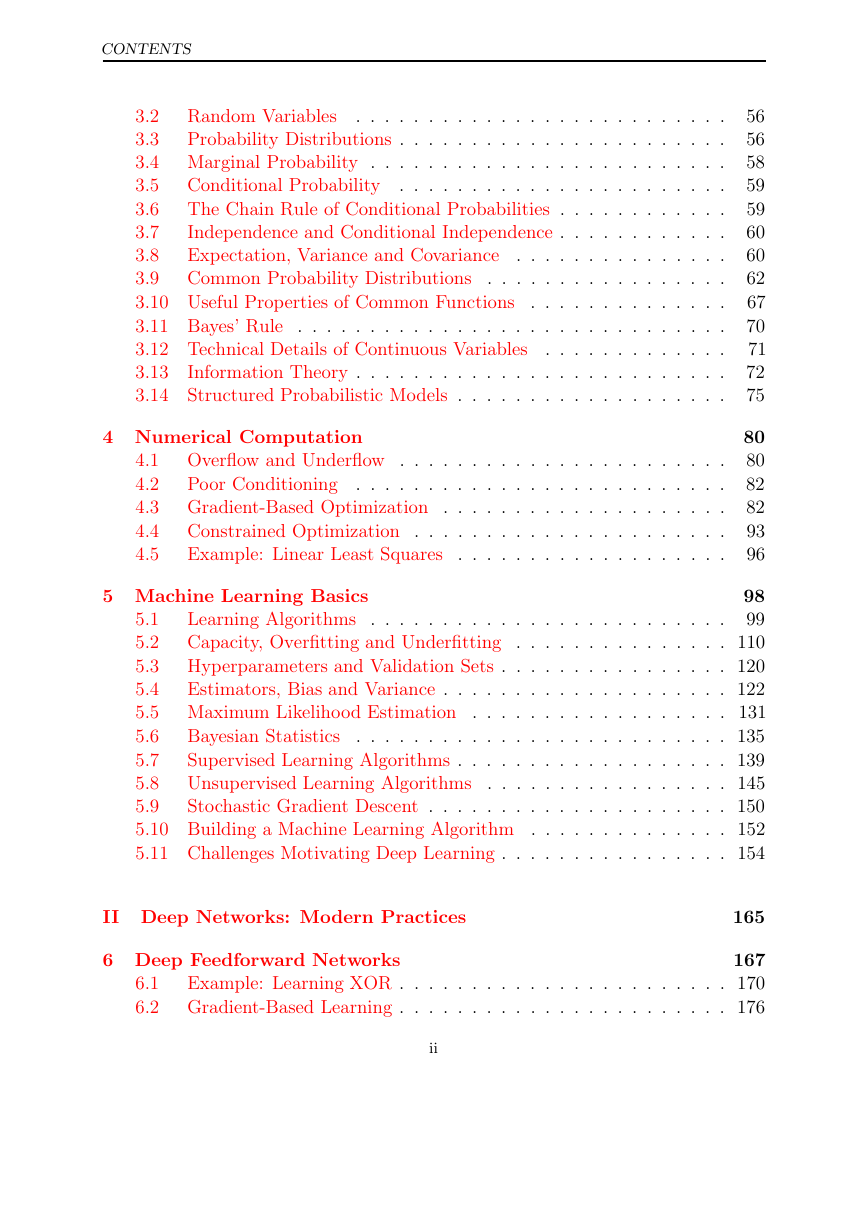
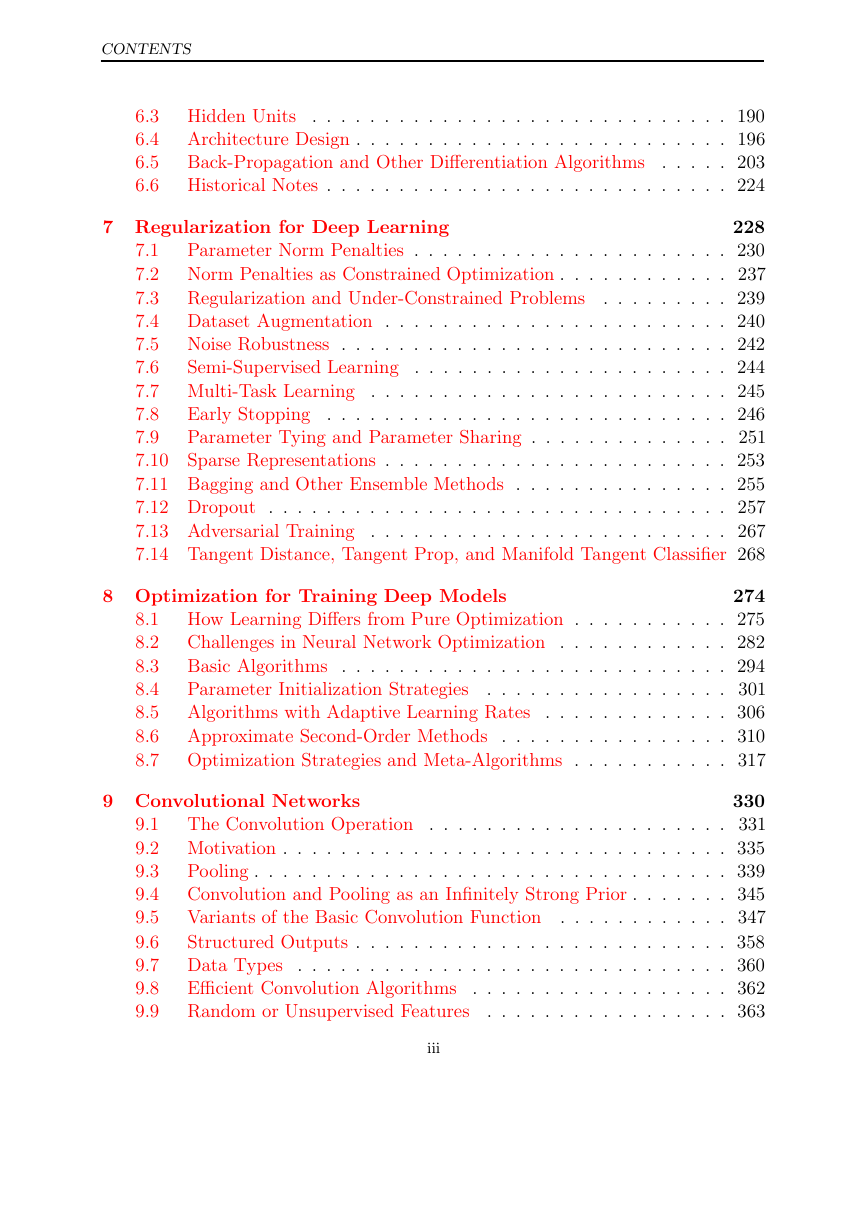
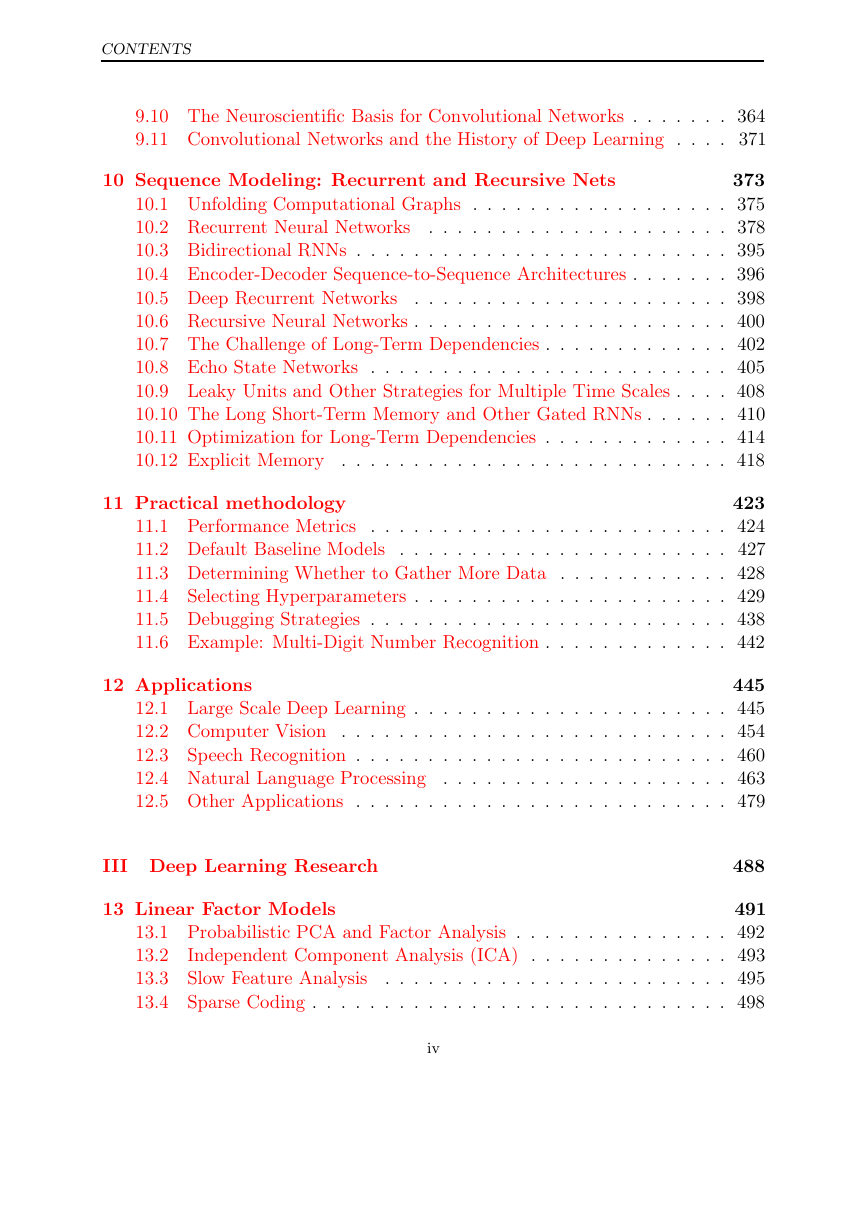
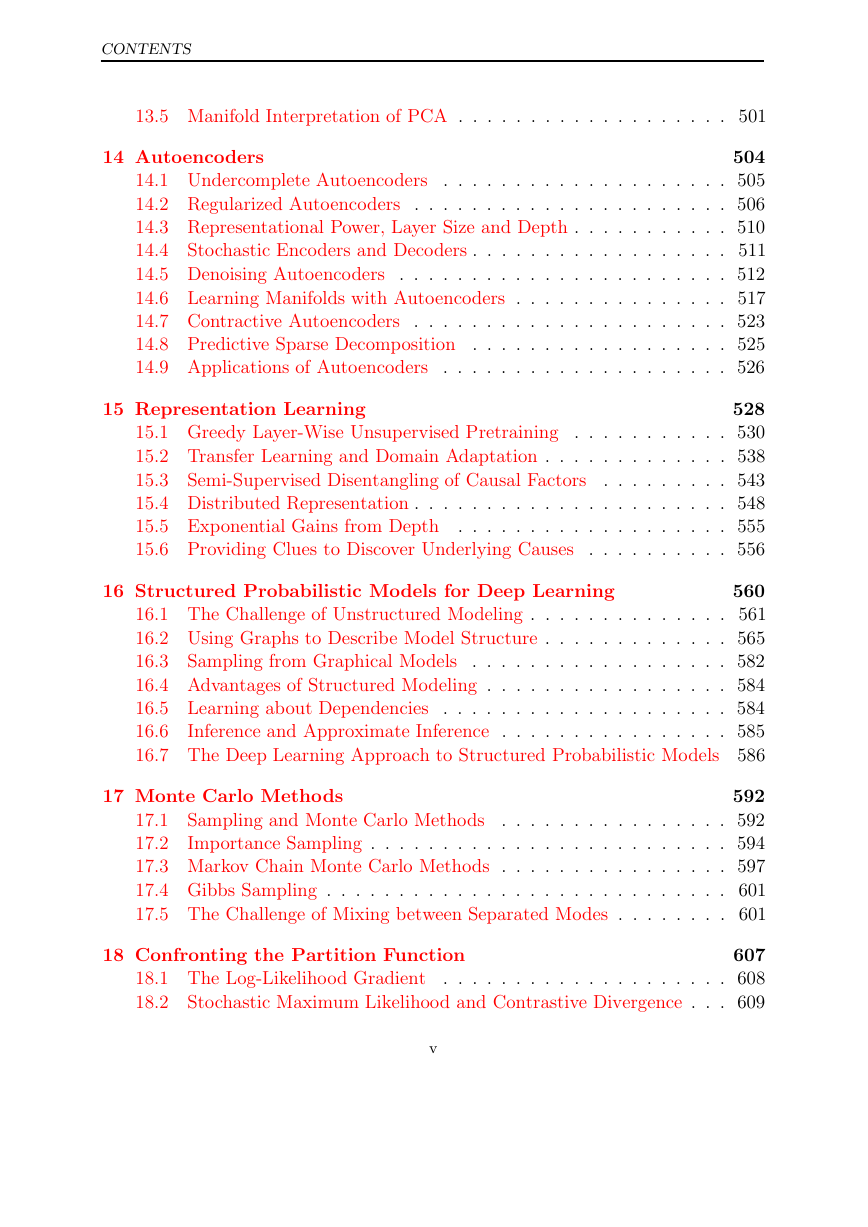
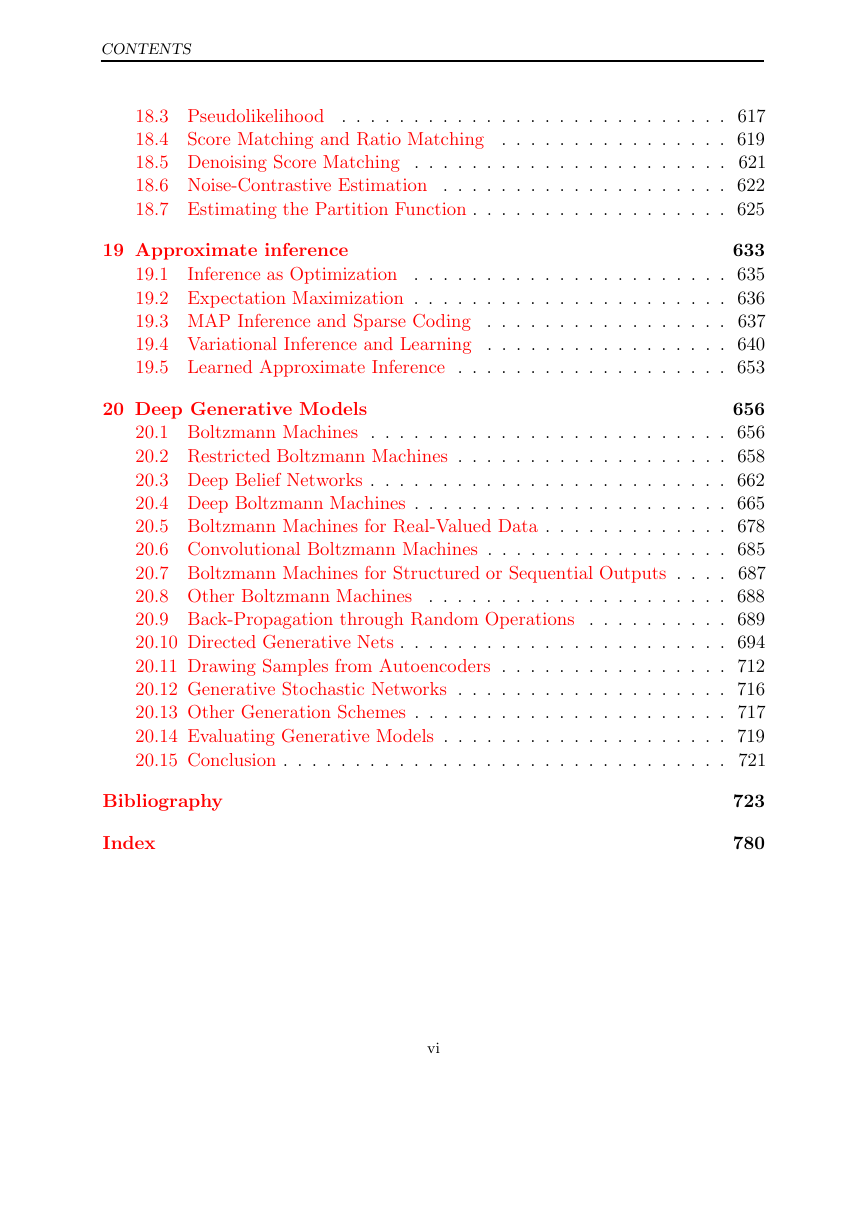
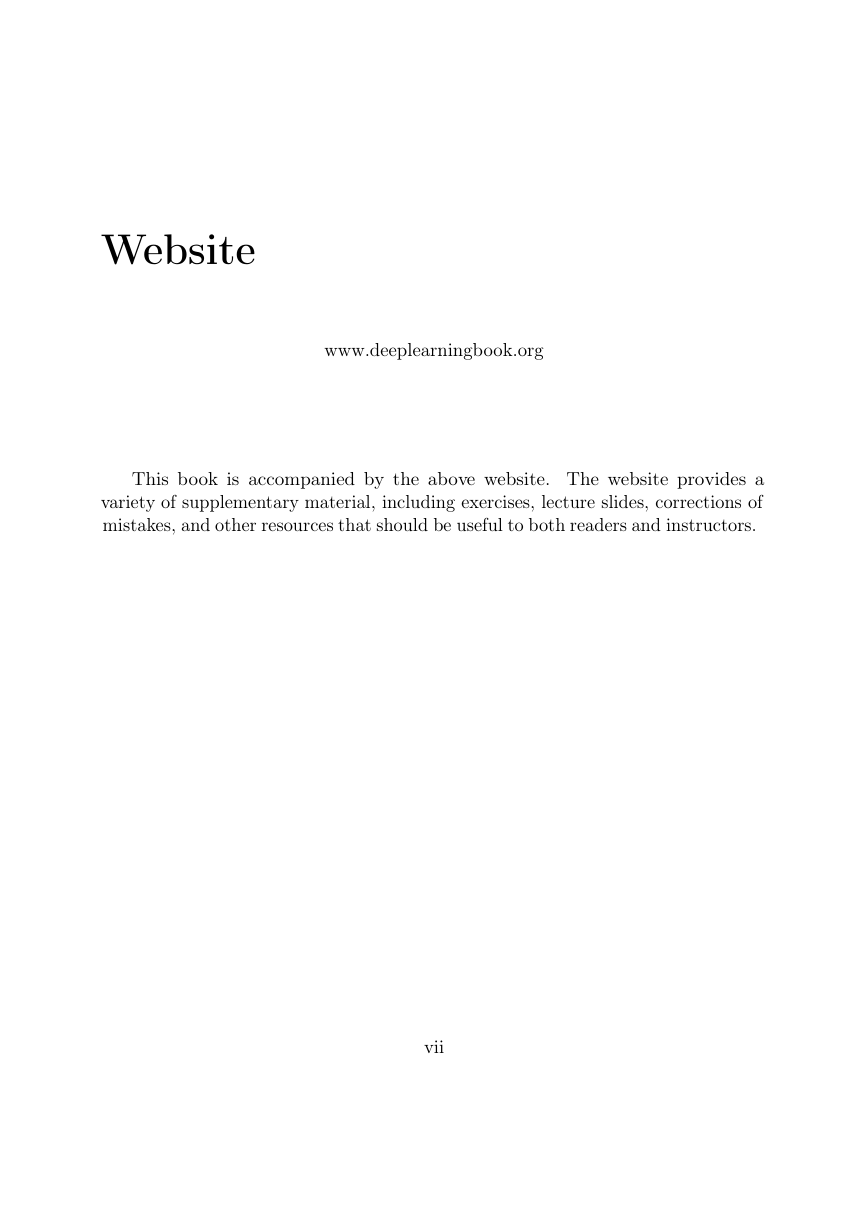








 2023年江西萍乡中考道德与法治真题及答案.doc
2023年江西萍乡中考道德与法治真题及答案.doc 2012年重庆南川中考生物真题及答案.doc
2012年重庆南川中考生物真题及答案.doc 2013年江西师范大学地理学综合及文艺理论基础考研真题.doc
2013年江西师范大学地理学综合及文艺理论基础考研真题.doc 2020年四川甘孜小升初语文真题及答案I卷.doc
2020年四川甘孜小升初语文真题及答案I卷.doc 2020年注册岩土工程师专业基础考试真题及答案.doc
2020年注册岩土工程师专业基础考试真题及答案.doc 2023-2024学年福建省厦门市九年级上学期数学月考试题及答案.doc
2023-2024学年福建省厦门市九年级上学期数学月考试题及答案.doc 2021-2022学年辽宁省沈阳市大东区九年级上学期语文期末试题及答案.doc
2021-2022学年辽宁省沈阳市大东区九年级上学期语文期末试题及答案.doc 2022-2023学年北京东城区初三第一学期物理期末试卷及答案.doc
2022-2023学年北京东城区初三第一学期物理期末试卷及答案.doc 2018上半年江西教师资格初中地理学科知识与教学能力真题及答案.doc
2018上半年江西教师资格初中地理学科知识与教学能力真题及答案.doc 2012年河北国家公务员申论考试真题及答案-省级.doc
2012年河北国家公务员申论考试真题及答案-省级.doc 2020-2021学年江苏省扬州市江都区邵樊片九年级上学期数学第一次质量检测试题及答案.doc
2020-2021学年江苏省扬州市江都区邵樊片九年级上学期数学第一次质量检测试题及答案.doc 2022下半年黑龙江教师资格证中学综合素质真题及答案.doc
2022下半年黑龙江教师资格证中学综合素质真题及答案.doc